Configure CCE Agent Answers and Call Transcripts with Google Agent Assist
Available Languages
Download Options
Bias-Free Language
The documentation set for this product strives to use bias-free language. For the purposes of this documentation set, bias-free is defined as language that does not imply discrimination based on age, disability, gender, racial identity, ethnic identity, sexual orientation, socioeconomic status, and intersectionality. Exceptions may be present in the documentation due to language that is hardcoded in the user interfaces of the product software, language used based on RFP documentation, or language that is used by a referenced third-party product. Learn more about how Cisco is using Inclusive Language.
Contents
Introduction
This document describes how to configure Contact Center Enterprise (CCE) Agent Answers and Transcripts integrated with Google Contact Center Artificial Intelligence (CCAI).
Contributed by Ramiro Amaya and Carlos Angulo Mireles, Cisco TAC Engineers and Adithya Udupa, Anjum Jeelani, and Raghu Guvvala, Cisco Engineers.
Prerequisites
Requirements
Cisco recommends that you have knowledge of these topics:
- Cisco Unified Contact Center Enterprise (UCCE) Release 12.6.2
- Cisco Package Contact Center Enterprise (PCCE) Release 12.6.2
- Customer Voice Portal (CVP)
- Cisco Finesse 12.6.2
- Cisco Unified Border Element (CUBE) or Voice Gateway (GW)
- Google Agent Assist
- Control Hub
- CCE Admin Data Server (AW)
- CVP Operations and Management Portal (OAMP)
Components Used
The information in this document is based on these software versions:
- UCCE Release 12.6.2
- CVP 12.6.2 ES15
- Cisco Finesse 12.6.2
- Google Agent Assist
- Control Hub
- VCUBE - Cisco IOS XE Bengaluru 17.12.1a
Note: For CUBE / VCUBE Cisco IOS version supported, please refer to the latest PCCE/UCCE Features Guide and Compatibility matrix
The information in this document was created from the devices in a specific lab environment. All of the devices used in this document started with a cleared (default) configuration. If your network is live, ensure that you understand the potential impact of any command.
Background
CCE 12.6 introduces the Agent Answers feature, in which an agent is provided with relevant suggestions and recommendations in real time for the agent to consider. The suggestions and recommendations are based on the conversation between the caller and the agent.
More often, agents lack the depth of knowledge about the products and services of the business they serve. Agent Answers enhances your experience because the timely suggestions improve the ability of the agent to respond. Businesses can cut down on training costs and time.
In addition CCE 12.6 also introduces Call Transcripts services that assist the agents by the use of Artificial Intelligence (AI) and Natural Language Understanding (NLU). These services are available for the agents in the Cisco Finesse desktop gadgets.
The Call Transcript gadget dynamically converts the ongoing conversation to text and presents the text to an agent for real-time viewing and reference.
Configure
Configuration Requirements
-
Ensure that your CCE AW server has 443/8443 ports opened and is able to access these websites:
-
*.wbx2.com
-
*.ciscoccservice.com
-
-
Ensure that CUBE has access to these websites:
-
*.cisco.com
-
*.ciscospark.com
-
*.rtmsprod.net
-
*.wbx2.com
-
-
Ensure that Packaged CCE AW, OAMP on UCCE, Cloud Connect, CUBE, and Agent Desktop components have access to Webex services to use the Agent Answers.
Google Agent Assist
Agent Assist is a Google Contact Center Artificial Intelligence (CCAI) solution which uses machine learning technology to provide suggestions to your human agents when they are in a conversation with a customer.
Suggestions are based on your own uploaded data and therefore can be tailored to your specific business needs. This uploaded data is part of your own knowledge base.
Note: There is no Dialogflow CX configuration required for Agent Answers and Call Transcripts
Create a Knowledge Base
A knowledge base represents a collection of knowledge documents that you provide via Agent Assist. Your knowledge documents are provided to the Finesse agents and contain information that can be useful during the agent conversation with customers. This helps to minimize agents training and improves agent response to customer calls.
Step 1. Open a web browser and navigate to https://agentassist.cloud.google.com/
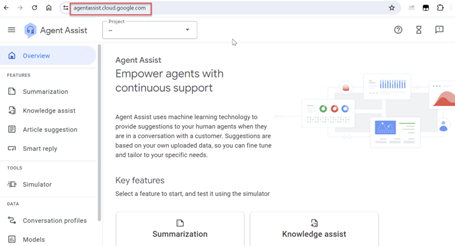
Step 2. Log in with the same account you used to create your Google project. Select the Project and the location.
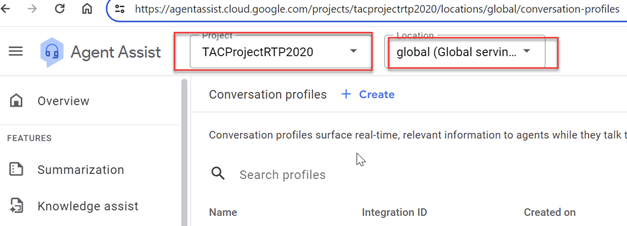
Step 3. Select Knowledge bases on the left sidebar menu.
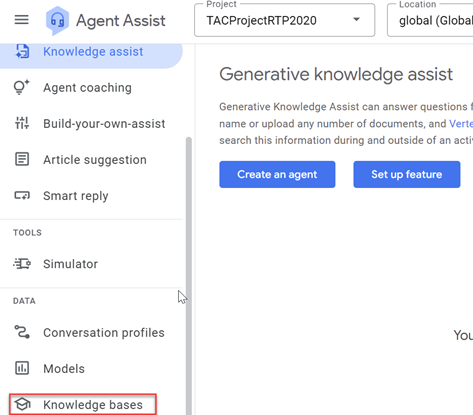
Step 4. Click Create under Knowledge bases.
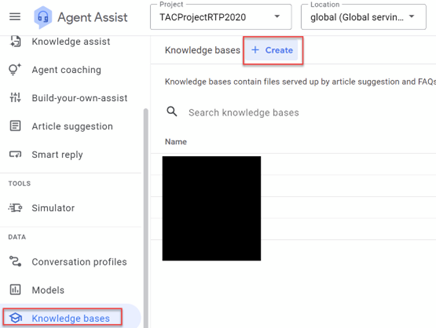
Step 5. Enter a knowledge base name and language and click Create.

Step 6. Add a document to the Knowledge base. Click Create New and enter the information.
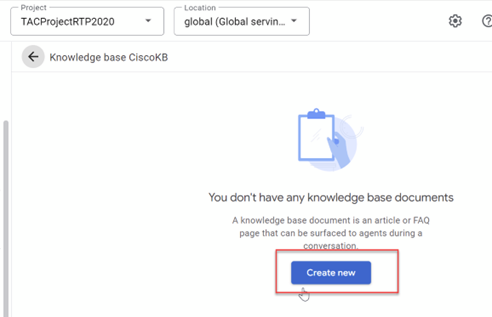
a. Select the Knowledge Type, in this example you can use FAQ.
b. Select Public URL for File source. In this example you can use the Google FAQ document: https://cloud.google.com/storage/docs/faq.
c. Click CREATE.
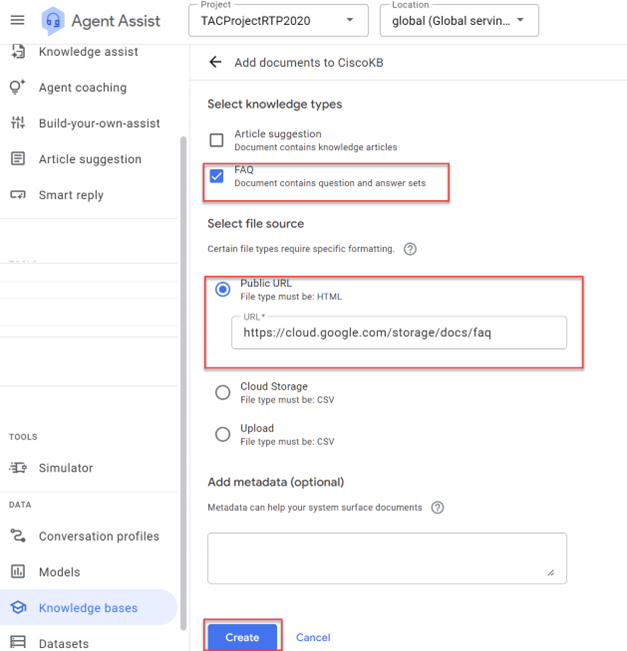
the document is now created. You can add more documents to the knowledge base with the same procedure.
Create a Conversation Profile
A conversation profile configures a set of parameters that control the suggestions made to an agent. These parameters control the suggestions that are surfaced during runtime. You must create a conversation profile in order to establish a dialog with an end-user and this a required parameter for the CCAI CCE Features configuration.
Step 1. On the Google Agent Assist, select Conversation profiles from the left sidebar menu.

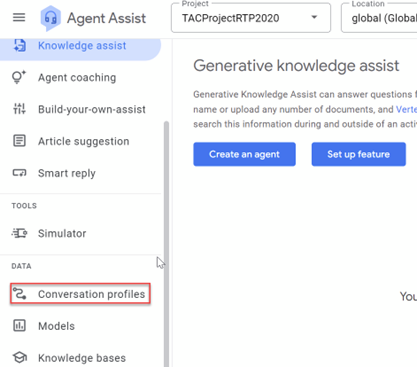
Step 2. Click +Create new, on the top right of the page or +Create if you have already created other conversation profiles.
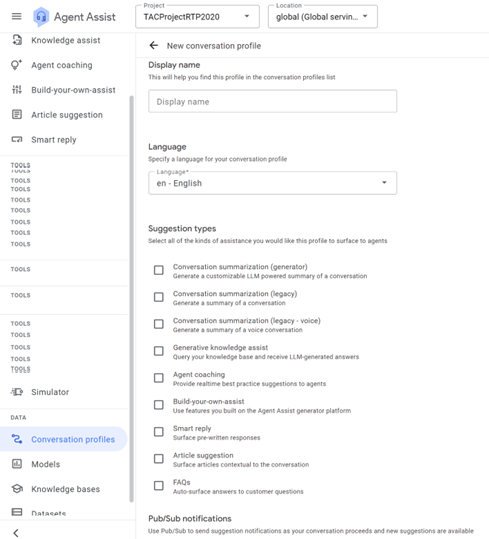
Step 3. In the Display name box, enter a unique name for your conversation profile and select the language.
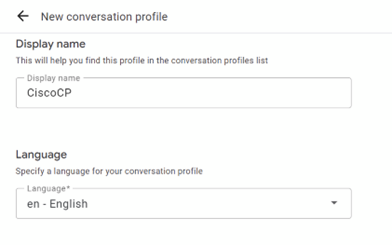
Step 4. From the list of available options, for Suggestion types select FAQ.
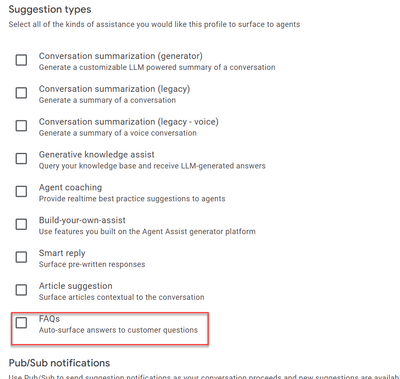
Step 5. When you select the suggestion type, you see the options to enter the Confidence threshold and Maximum suggestions values. Maximum suggestions are the number of response suggestions or knowledge suggestions returned, and the confidence threshold refers to the model level of confidence that each knowledge suggestion or response suggestion is relevant to the customer request. A higher confidence value increases the likelihood of relevant responses being returned but can result in fewer or no responses returned if no available option meets the high threshold value. For FAQ, Google suggest that you set the confidence threshold to FAQ Assist=0.4. Google also recommends that you start with a maximum suggestions value of 3 in all cases.
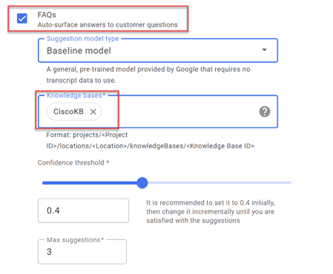
Step 6. (Optional) Enable Sentiment analysis. This feature analyzes messages from both the agent and end-user to determine emotional intent. For now, leave it disabled.
Step 7. (Optional) Enable handoff to a Dialogflow virtual agent. Virtual agents are automated agents that attempt to resolve customer issues before escalating to a human agent. For this feature there is no need to select the virtual agent, but if you want the customer call to be handled by a Dialogflow CX Virtual agent first before the call is transferred to a real agent, you can enable this option and select the Dialogflow CX virtual agent you created in this project.
Step 8. Click Create. It takes several minutes until the conversation profile is ready to use.
Note: When you configure Agent Answers in Control Hub, you need to provide the Conversation profile id. Copy the Integration ID. Click Copy to Clipboard. This is used later in the Control Hub configuration.

Webex Control Hub Configuration
Create a CCAI configuration in Cisco Webex Control Hub at Control Hub. A CCAI configuration leverages CCAI Connectors to invoke the CCAI services. For details, visit the Configure Contact Center AI article at Webex Help Center.
Step 1. Ensure that the Cloud Connect publisher and subscriber are installed. For more information, visit the Install Cloud Connect section in Cisco Unified Contact Center Enterprise Installation and Upgrade Guide.
Step 2. Log in to Webex Control Hub. Navigate to Contact Center and click Cloud Connect.
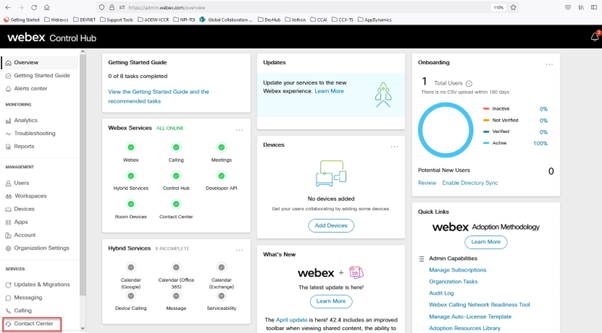
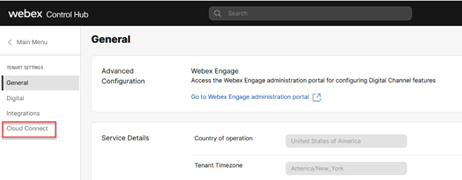
Step 3. On Cloud Connect window enter the name and the Fully Qualified Domain Name (FQDN) of Primary Cloud connect.

Step 4. On Cloud Connect window enter the name and the FQDN of Primary Cloud connect and click Register.
Step 5. On the Allow Access window, check the box Allow Access to the Cloud Connect Node and click Continue.
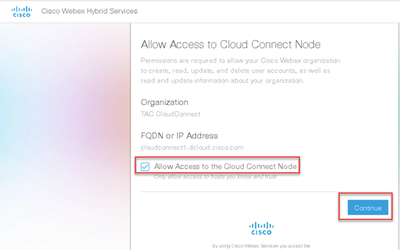
Step 6. Add a Connector. On the Contact Center window select Integrations and then Connectors. Click Add More.
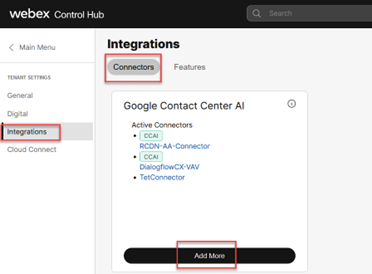
Step 7. If a connector is already added and you need to add one more, click on Add More. Sign in with Google and continue with the instructions.
Note: The user account that you sign in with Google must have the owner role of the Google project.

Step 8. On the Connector page provide this information and click Save.
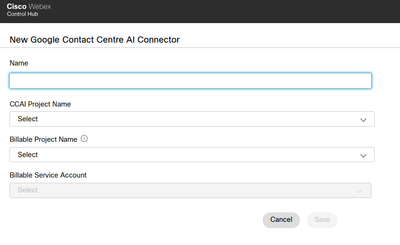
Name: Name of the Connector
CCAI Project Name: Name of the Google project you have created
Billable Project Name: Name of the Google project Cisco provided when you provisioned your Google project
Billable Service Account: Service account that Cisco provided, and you added to your Google project.
Now the connector is created, and a Jason key is automatically created in the Cisco Google project.
Step 9. Add the features. On the Contact Center -> Integration page, click Features and click New.

Step 10. You are now in the Create a New Contact Center Feature page. Click Contact Center AI Config.
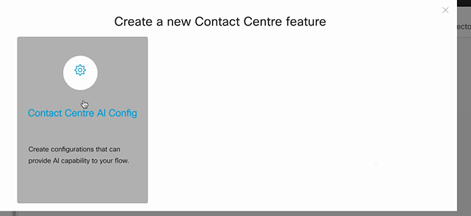
Step 11. Provides the feature information, select the connector already added, and the Google conversation profile created.
Config Name: Any Name you want to call this feature. For example. AA-TACRCDN
Description(Optional): For example: Agent Answers feature for RCDN
Connector: Select the Connector previously created
Google Conversation profile: Copy the Conversation profile form Agent Assist.
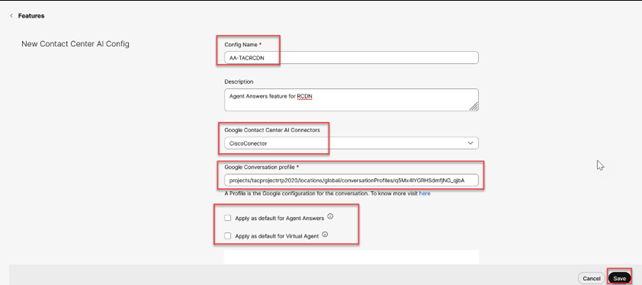
Note: You can select this feature as the default for Agent Answers and Virtual Agent. In that case you would not need to associate a configured feature with contact Center Call Type.
CCE Configuration
Step 1. On PCCE AW, open Cisco Web Administration tool (SPOG) and navigate to Inventory. Click New.
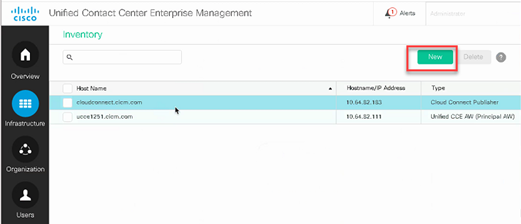
Step 2. Add Cloud Connect and provide the FQDN and credentials.
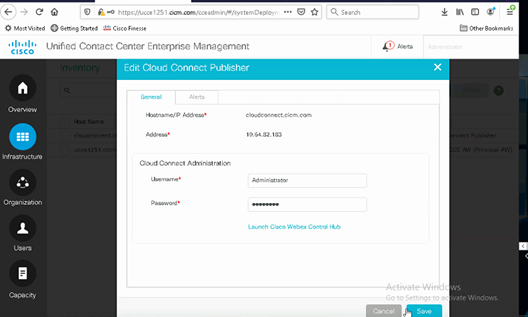
Note: Refer to these documents for PCCE certificate exchange: Self-Signed Certificates in a PCCE Solutions and Manage PCCE Components Certificate for SPOG. For UCCE refer to Self-Signed Certificate Exchanged on UCCE.
Step 3. Configure Cloud Connect in the CVP Operations Console (OAMP). For details visit the section Configure CVP Devices for Cloud Connect in the Administration Guide for Cisco Unified Customer Voice Portal.
Note: This is for UCCE only. This step is not required for PCCE.
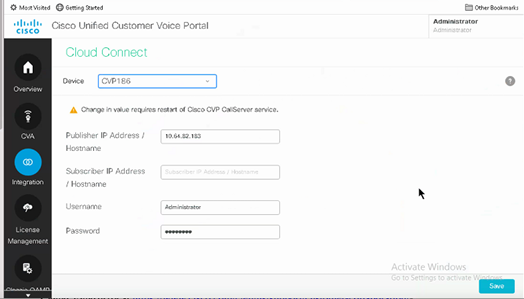
Step 4. Import the Cloud Connect certificate to the CVP server. For details, visit the section Import Cloud Connect Certificate to Unified CVP Keystore in the Configuration Guide for Cisco Unified Customer Voice Portal.
Step 5. To associate the CCAI configuration to all call types, you need to ensure you have selected a default agent answers feature in Control Hub. In the Unified CCE Administration, navigate to Overview > Features > Contact Center AI and select Cisco Bill, then you can see the default agent answers feature selected for all call types.

Step 6. To apply the CCAI configuration to only a subset of the call types or to override the global configuration for specific call types do this.
1. In Web Administration tool, navigate to Call settings -> Route Settings and select Call Type.
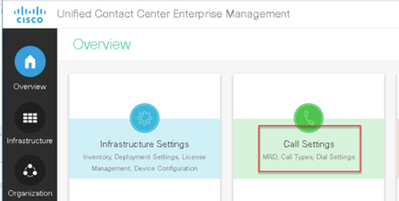
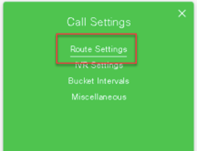
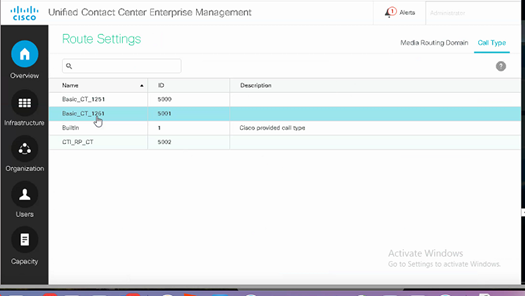
2. Click the Contact Center AI tab and select the Contact Center AI configured on the Control Hub and click Save.
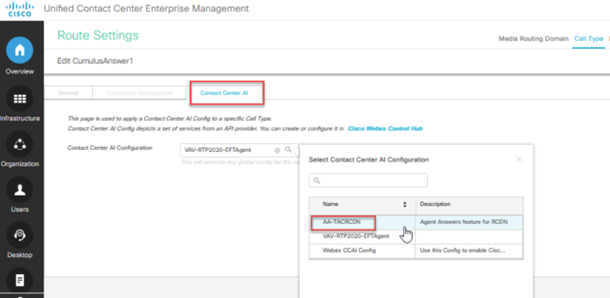
Finesse Configuration
Note: Steps 1 to 3 are for UCCE only. For PCCE start with Step 4.
Step 1. Provision Cloud Connect on Cisco Finesse. For more information, visit the Cloud Connect Server Settings topic in the Cisco Finesse Administration Guide.
Step 2. Open Finesse Admin page, and navigate to settings and to Cloud Connect.
Step 3. On the Cloud Connect Server Settings provide the credentials and the FQDN of the publisher and the subscriber.
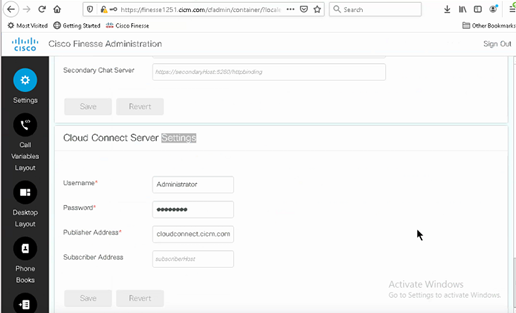
Step 4. Add the Agent Answers gadget on the Finesse Desktop Layout. On the Cisco Finesse Administration Page, click Desktop Layout and remove the comment on the gadget information related to Agent Answers.
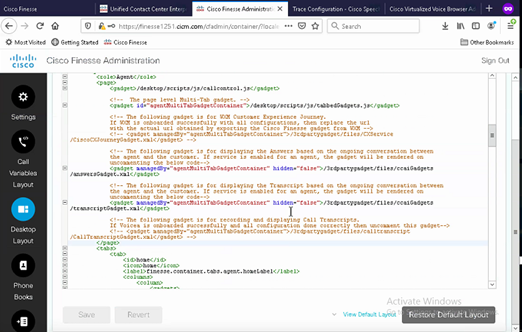
Step 5. On CCE Administration Page select Agents and on Manage Agents enable the CCAI services. Once enabled, the Agent Answers gadget appears on the Home tab and displays relevant articles and suggestions during a call. For details on how to use the gadget, visit the Contact Center AI Gadgets guide. Gadget auto-hide/un-hide and notifications capability is available only if the gadget is configured as a multi-tab gadget in Cisco Finesse. For more details, visit Agent Answers Gadget in the Cisco Cisco Finesse Administration Guide.
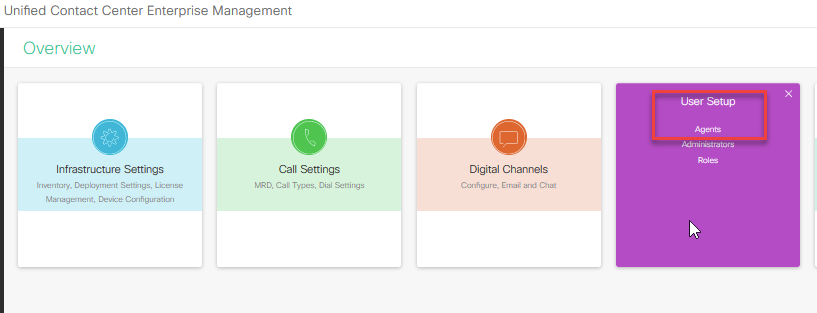
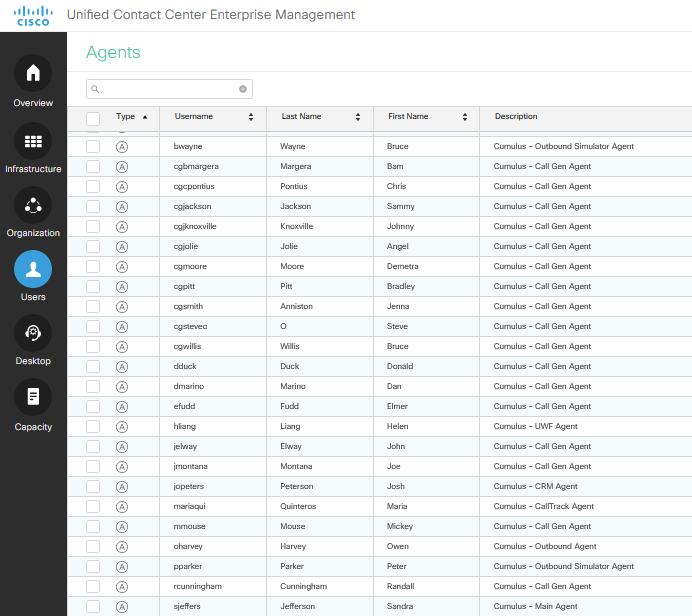
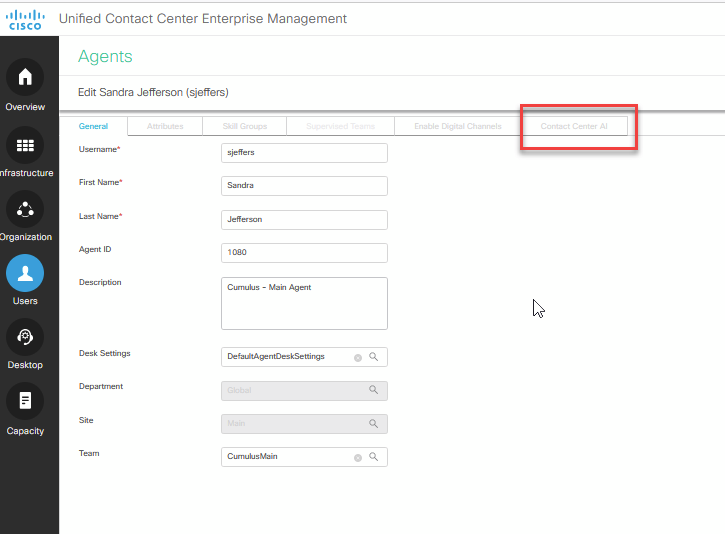
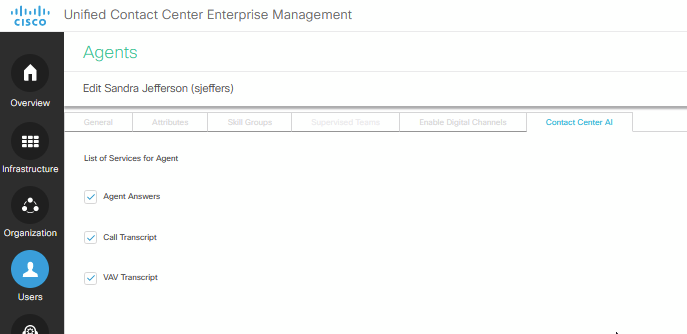
Note: If in the Finesse servers you have cors allowed_origin configured, make sure to add the cloud connect servers with this command: utils finesse cors allowed_origin add https://{Cloudconnect FQDN}. Restart the Finesse tomcat and the Finesse Notification Service after you add the cloud connect servers.
CUBE and CVP Configuration
Ensure Agent Answers is configured on a supported CUBE platform. For more details on supported CUBE platforms and configuration, see the WebSocket-Based Media Forking for Cloud Speech Services chapter in the Cisco Unified Border Element Configuration Guide - Cisco IOS XE 17.6 Onwards at https://www.cisco.com/c/en/us/td/docs/ios-xml/ios/voice/cube/ios-xe/config/ios-xe-book/websocket-forking-for-cube.html.
Note: Agent Answers feature uses the RTMS Data Center Webex Services on CCE 12.6.2 and CVP 12.6.2 ES15 onwards, instead of the WxCC Data Center Webex Services . RTMS Webex Services support only GCM ciphers. Cisco IOS XE 17.12.1a onwards have GCM ciphers enabled. For CUBE / VCUBE Cisco IOS version supported, please refer to the latest PCCE/UCCE Features Guide and Compatibility matrix.
Step 1. On CUBE / VCUBE, enter to config mode.
Config t
Step 2. Create a Voice Class Sip profile to add Call-Info SIP header in INVITE message for CVP to send forking request.
voice class sip-profiles 100
request INVITE sip-header Call-Info add "X-Cisco-Forking: supported"
Step 3. Create a media stream service profile.
media profile stream-service 99
connection idle-timeout 45 ! default 30 mins
connection calls-threshold 5 ! default 3 calls per websocket connection
proxy host proxy.dk.org ! optional, http proxy server IP or DNS if used
source-ip A.B.C.D ! VCUBE source IP for websocket sessions
Step 4. Associate media stream service profile to a media class.
media class 9
stream-service profile 99
Step 5. Add the sip and media profile to the outgoing dial-peer towards CVP.
dial-peer voice 802 voip
description CVP SIP Comprehensive dial-peer
destination-pattern 802.
session protocol sipv2
session target ipv4:X.X.X.X
voice-class codec 1
voice-class sip profiles 100
media-class 9
dtmf-relay rtp-nte
no vad
Note: These media forkings are not supported: Network-Based Recording, Media Proxy and Extended Media Forking - XCC or XMF
Verify
There is currently no verification procedure available for this configuration.
Troubleshoot
There is currently no specific information to troubleshoot available for this configuration.
Related Information
Revision History
| Revision | Publish Date | Comments |
|---|---|---|
1.0 |
17-Sep-2024 |
Initial Release |
Contributed by Cisco Engineers
- Ramiro Amaya and Carlos AnguloCisco TAC Engineers
- Adithya UdupaCisco Engineer
- Anjum Jeelani and Ragu GuvvalaCisco Engineer
Contact Cisco
- Open a Support Case

- (Requires a Cisco Service Contract)
 Feedback
Feedback